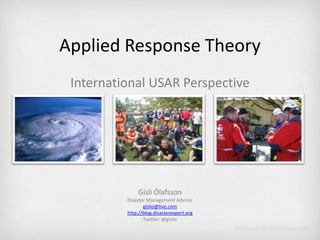
Applied Disaster Response Theory
- 1. Applied Response Theory International USAR Perspective Gísli Ólafsson Disaster Management Advisor gislio@live.com http://blog.disasterexpert.org Twitter: @gislio
- 2. INSARAG
- 5. INSARAG was established in 1991 following lessons learned in the 1988 Armenia earthquake INSARAG Established
- 6. Platform for its stakeholders to define standards for international USAR assistance develop methodology for international cooperation and coordination in earthquake response INSARAG Introduction
- 7. Sponsored by Turkey, co-sponsored by 58 countries, unanimously accepted after 2 year discussion Measures to improve speed, effectiveness of international USAR assistance Endorses use of INSARAG Guidelines Endorses coordination support to disaster affected country by UNDAC team Encourages regional cooperation in USAR Encourages member states to resolve administrative delays to deploying USAR teams e.g. customs entry procedures, visas, overflight UN GA Resolution 57/150 of 16 Dec 2002
- 8. Haiti Earthquake – January 12th, 2010
- 10. Virtual OSOCC
- 13. Getting there
- 14. Getting out
- 15. Connectivity
- 16. Reception Center
- 17. Customs Immigration USAR Teams AST LEMA Reception Center
- 18. Reconnaissance BoO Location OSOCC Location LEMA Initial Rescues The First 48 Hours
- 20. Reconnaissance
- 21. BoO Location
- 22. BoO Location
- 23. OSOCC RDC MINUSTAH Airport Building OSOCC Location
- 24. OSOCC Location
- 25. LEMA
- 26. Initial Rescues
- 28. High tech job?
- 30. The reason why we do this!
- 32. OCHA Video
- 33. Overall Coordination at the MINUSTAH USAR Coordination at the airport 1. RDC at PAP 2. RDC at SD Coordination Structure
- 35. OPC at BoO
- 36. Front Desk
- 37. Communications
- 39. Mapping
- 40. Planning
- 41. Planning
- 42. Assessments
- 45. USAR Team Coordination Meetings
- 47. They got there first
- 51. Social Networks
- 52. Photo: Reuters Psychological Effects
- 53. Lessons learned
- 54. Thank you!
Hinweis der Redaktion
- ICE-SAR- Founded 1929- 100 rescue teams- 1000 missions each year- International USAR team founded in 1995- Integral part of the Icelandic disaster response frameworkBackgroundICE-SARINSARAGUNDACHaitiAlertGetting thereFirst 24 hoursCoordinating the chaosDealing with mediaPsychological aspectsLessons learnedUNDACFounded in 1993Came from INSARAG250 emergency managers from 75+ countries200+ missionsAverage 12 missions per yearOn call 24/7/365 for deployment with 4-8 hour noticeMethodology, training, equipment
- Transportation the bottleneckOur flightplanLanding permissionsGetting out of the plane...Who is there when we get there?Setting up a reception center
- Transportation the bottleneckOur flightplanLanding permissionsGetting out of the plane...Who is there when we get there?Setting up a reception center
- ReconnasanceFinding a place for BoOFinding a place for OSOCCInteraction with LEMAReporting the situation backInitial rescues
- Establishing an OSOCCRole of the OSOCCRoles within the OSOCCManning the OSOCCRole of GISLogistics issuesCommunication issuesSecurity issues
- Dealing with death and destructionEffects on seasoned first respondersDealing with incident stress during the missionDealing with incident stress following the mission
- Prepare and train for the worst, then expect to exceed what you prepared forProcess of classification of team paid offInformation management complexity of disasters of this magntitude are underestimatedOperational planning and coordination aspects of UNDAC/INSARAG need to be improved – need to scale up/down with incidentDisaster tourists cause bottlenecks
- Thank you!
